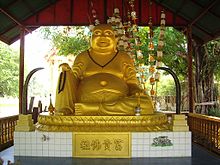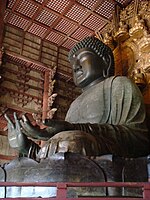Budai
| Budai | |||||||||||||||
|---|---|---|---|---|---|---|---|---|---|---|---|---|---|---|---|
| File:Buddha Beipu.jpg | |||||||||||||||
| Chinese name | |||||||||||||||
| Chinese | 布袋 | ||||||||||||||
| |||||||||||||||
| Alternative Chinese name | |||||||||||||||
| Chinese | 笑佛 | ||||||||||||||
| Literal meaning | Laughing Buddha | ||||||||||||||
| |||||||||||||||
| Vietnamese name | |||||||||||||||
| Vietnamese alphabet | Bố Đại | ||||||||||||||
Budai or Pu-Tai[1][2] (Chinese: 布袋; pinyin: Bùdài), or 布袋 (Hotei) in Japanese,[3] Bố Đại in Vietnamese, is a Chinese folkloric deity. His name means "Cloth Sack,"[3] and comes from the bag that he is conventionally depicted as carrying. He is usually identified with or seen as an incarnation of Maitreya, the future Buddha, so much so that the Budai image is one of the main forms in which Maitreya is depicted in China.[3] He is almost always shown smiling or laughing, hence his nickname in Chinese, the Laughing Buddha (Chinese: 笑佛).[1][3][4] In the West, the image of Budai is often mistaken for Gautama Buddha.[5]
Description
Budai is traditionally depicted as an obese, bald man wearing a robe[1][4][6] and wearing or otherwise carrying prayer beads. He carries his few possessions in a cloth sack,[4] being poor but content. He is often depicted entertaining or being followed by adoring children.[3] His figure appears throughout Chinese culture as a representation of contentment.[4]
History
According to Chinese history, Budai was an eccentric Chán monk (Chinese: 禅; pinyin: chán)[7] who lived in China during the Later Liang (907–923 AD). He was a native of Zhejiang, and his Buddhist name was Qieci (Chinese: 契此; pinyin: qiècǐ; lit. 'Promise this').[2] He was considered a man of good and loving character.[3]
Budai is often conflated with the historical Buddha, Siddhartha Gautama,[2][8][9] in spite of the distinct visual differences in how each has been depicted. In India, Nepal, and throughout southeast Asia, Gautama (who lived during the 6th century BC) is commonly depicted as being tall and slender in appearance. In contrast, in China and those areas to which Chinese cultural influence spread, the depiction of Budai (who lived during the 10th century AD) is consistently short and round.[10]
Traditions that revere Budai
Folklore



Budai in folklore is admired for his happiness, plenitude, and wisdom of contentment. One belief popular in folklore maintains that rubbing his belly brings wealth, good luck, and prosperity.
In Japan, Hotei persists in folklore as one of the Seven Lucky Gods (Shichi Fukujin) of Taoism.[6]
Buddhism
Some Buddhist traditions consider him a Buddha or a bodhisattva, often identifying him with Maitreya (the future Buddha).[1][4][6][11]
His identification with the Maitreya is attributed to a Buddhist hymn (Chinese: 偈语; pinyin: jìyǔ) he uttered before his death:[12]
- 彌勒真彌勒,化身千百億,時時示時人,時人自不識
Maitreya, the true Maitreya
has billions of incarnations.
Often he is shown to people at the time;
other times they do not recognize him.
Zen
The primary story that concerns Budai in Zen (Chán) is a short kōan.[13] In it, Budai is said to travel giving candy to poor children, only asking a penny from Zen monks or lay practitioners he meets. One day a monk walks up to him and asks, "What is the meaning of Zen?" Budai drops his bag. "How does one realize Zen?" Budai then takes up his bag and continues on his way.[3][13]
Many versions of the Ten Bulls feature Hotei in the tenth picture.[3]
I Kuan Tao
Statues of Budai form a central part of I Kuan Tao shrines, where he is usually referred to by the Sanskrit name Maitreya.[14] According to I Kuan Tao, he represents many teachings, including contentment, generosity, wisdom and open kindheartedness.[14] He is predicted to succeed Gautama Buddha as the next Buddha, and helps people realize the essence within, which connects with all beings.

Conflation with other religious figures
Angida Arhat
Angida was one of the original eighteen Arhats of Buddhism. According to legend, Angida was a talented Indian snake catcher whose aim was to catch venomous snakes to prevent them from biting passers-by. Angida would also remove the snake's venomous fangs and release them. Due to his kindness, he was able to attain bodhi.
In Chinese art, Angida is sometimes portrayed as Budai, being rotund, laughing, and carrying a bag.[7]
Phra Sangkajai / Phra Sangkachai
In Thailand, Budai is sometimes confused with another similar monk widely respected in Thailand, Phra Sangkajai or Sangkachai (Thai: พระสังกัจจายน์). Phra Sangkajai, a Thai rendering of Maha Kaccana or Mahakaccayanathera (Thai: มหากัจจายนเถระ), was a Buddhist Arhata (in Sanskrit) or Arahant (in Pali) during the time of the Lord Buddha. Lord Buddha praised Phra Sangkadchai for his excellence in explaining sophisticated dharma (or dhamma) in an easily and correctly understandable manner. Phra Sangkajai (Maha Kaccana) also composed the Madhupinadika Sutra (Madhupindika Sutta MN 18).
One tale of the Thai folklore relates that he was so handsome that once even a man wanted him for a wife. To avoid a similar situation, Phra Sangkadchai decided to transform himself into a fat monk. Another tale says he was so attractive that angels and men often compared him with the Buddha. He considered this inappropriate, so disguised himself in an unpleasantly fat body.
Although both Budai and Phra Sangkajai may be found in both Thai and Chinese temples, Phra Sangkajai is found more often in Thai temples, and Budai in Chinese temples. Two points to distinguish them from one another are:
- Phra Sangkajai has a trace of hair on his head (looking similar to the Buddha's) while Budai is clearly bald.
- Phra Sangkajai wears the robes in Theravadin Buddhist fashion with the robes folded across one shoulder, leaving the other uncovered. Budai wears the robes in Chinese style, covering both arms but leaving the front part of the upper body uncovered.
References

- ^ a b c d Cook, Francis Dojun. How To Raise an Ox. Wisdom Publications. pp. 166 note 76. ISBN 9780861713172.
- ^ a b c "The Laughing Buddha". About.com. Retrieved April 20, 2013.
- ^ a b c d e f g h Leighton, Taigen Dan (1998). Bodhisattva Archetypes: Classic Buddhist Guides to Awakening and Their Modern Expression. New York: Penguin Arkana. p. 260-261. ISBN 0140195564. OCLC 37211178.
- ^ a b c d e "The Laughing Buddha". Religionfacts.com. Retrieved 2011-12-26.
- ^ Peterson, Christopher (July 17, 2012). "When Did the Buddha Become Fat?". Psychology Today. Retrieved December 5, 2014.
{{cite web}}: Italic or bold markup not allowed in:|publisher=(help) - ^ a b c "Hotei". Uwec.edu. 2008-11-16. Retrieved 2011-12-26.
- ^ a b Seo, Audrey Yoshiko; Addiss, Stephen (2010). The Sound of One Hand: Paintings and Calligraphy by Zen Master Hakuin. Shambhala Publications. p. 205. ISBN 9781590305782.
- ^ "Colbert tells Dalai Lama he'd better take China seriously". Lion's Roar. September 16, 2015. Retrieved September 19, 2015.
- ^ "Fat Buddha, Skinny Buddha, Laughing Buddha". Daily Buddhism. October 30, 2008. Retrieved September 19, 2015.
- ^ Asma, Stephen T. (2015). Buddha For Beginners. For Beginners, LLC. p. x. ISBN 9781939994332.
- ^ Stoneware figure of Budai ('Laughing Buddha') at British Museum
- ^ "Hotei, Pu-Tai, Maitreya, all known as the Laughing Buddha". Newsfinder.org. 2002-06-16. Retrieved 2011-12-26.
- ^ a b Hart, Addison Hodges (2014). The Ox-Herder and the Good Shepherd. Wm. B. Eerdmans Publishing. ISBN 9781467438988.
- ^ a b "Tao Living: Maitreya Buddha". Taoism.net. Retrieved 2011-12-26.
External links
 Media related to Hotei at Wikimedia Commons
Media related to Hotei at Wikimedia Commons Learning materials related to Buddha oracle#36 Laziness (The Happy Buddha) at Wikiversity
Learning materials related to Buddha oracle#36 Laziness (The Happy Buddha) at Wikiversity


